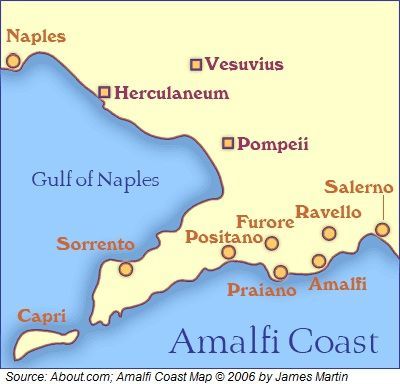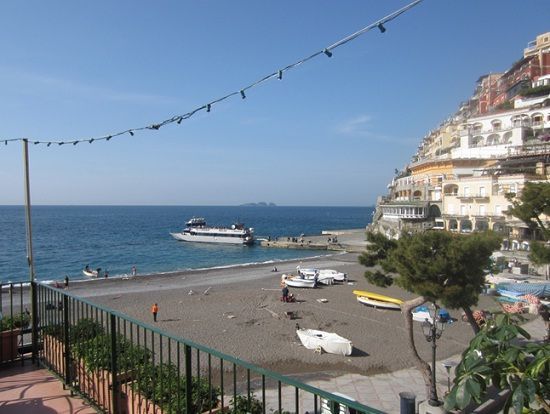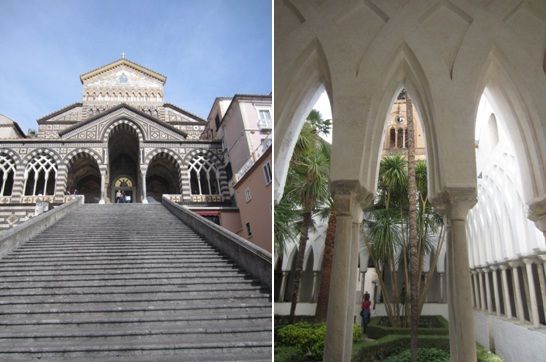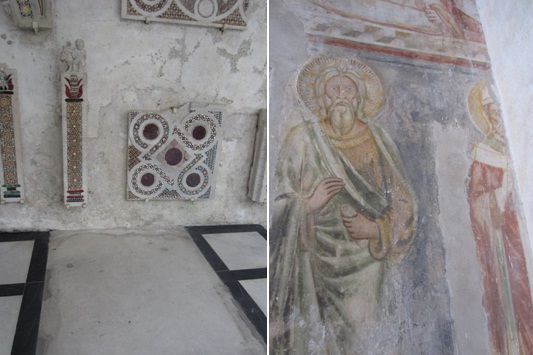Article
The Amalfi Coast in Southern Italy
Author(s):
The Amalfi Coast in Southern Italy combines pleasant relaxation with important historical sights.

“Sorrento is flat; Positano has lots of steps,” Adolfo, our driver from the Naples airport to Positano, told us. He was right.
Our hotel in Positano was built on a steep hill surrounded by steps and multiple shops. Cars can’t reach it. We never did figure out how our luggage appeared in our hotel from the small town square above.

The houses are built on a steep hill in Positano. This picture is from the breakfast balcony of our accommodation, the Hotel Buca di Bacco. The ferry, docked in this photo, was only steps away across the beach, which was just below our hotel.
It was night when we arrived. Our large room, 10, in Hotel Buca di Bacco didn’t display its innate glory after dark as it did in the daytime. But, once morning arrived, it was encompassed with light making one happy to be alive. Our large balcony made an effort to stretch itself to the sea. It gave us privacy, something most hotels with a sea view are short of in the village.
From Positano, it is possible to take a ferry several times a day to other coastal towns — among them Amalfi and Salerno. Later in the season there is water transport to Sorrento as well, but not in early April.
We took the half hour ride on the passenger vessel from Positano to Amalfi. Seeing the coast line from the water is a treat in itself, but once we reached Amalfi the real extravagance was visiting the cathedral on the Piazza del Duomo. Originally constructed in the early 9th century, it was rebuilt in the 11th and then remodeled several times. The church still has vestiges of its earlier glory and is easily one of the most interesting I have visited, in part because many of its original structures and frescos were still remaining.

The Arab influenced facade of the cathedral in Amalfi is made prominent by the sixty two steps that lead to its entrance. The Paradise Cloister within the cathedral dates to approximately 1266. It was built as a burial ground for the elite of Amalfi.

Original fragments from a 12th century floor are in the cloister (left). Frescos from the 14th to 17th century can be found in the cloister and Basilica itself.
Also in Amalfi is an ancient paper factory museum, the
which dates from the 13th century. Tours are conducted. The highlight is that the participants can “make” paper. Actually, this means dipping a screen in a mixture composed of cut up old rags and water previously created by an earlier multi-step process. For a video tour, please see this
.

The now-underground old Museo Della Carta in Amalfi. Notice the ancient water wheel in the lower left corner of the photos. This was used to transform water power generated from gravity to grinding energy to parse up rugs for paper.
Just above Amalfi is Ravello, which can be reached by a bus. It is here that the Ravello Festival takes place every year. Also, it was in Ravello that Richard Wagner is reported to have written the opera, “Parsifal.”
Paestum, another UNESCO Heritage site can be reached from Positano by taking a ferry to Salerno and transport from there. You could choose to drive yourself, which could be scary on the winding cliff roads, or hire a car. We liked the Positano Car Service — located in the town square above our hotel in Positano — that brought us from the Naples airport to Positano and used them again.
Michaela, our driver to Paestum, was totally accommodating, although the vegetable lunch he recommended turned out to be different varieties of local cheese with bread without anything healthy within shouting distance. It also cost 20 euros apiece and was hardly worth half as much. I would skip this in the future.
Michaela did tell us that he works seven months a year for the car transport service and receives 80% of his salary from the government the rest of the year. It is a good bet he doesn’t pay taxes on tips. So, grade school math suggests that he is the winner in this game and the government is losing. This may be one reason why he said, “We weren’t ready to join the European Union.”
We heard this elsewhere on our trip to Southern Italy.
During the winter, only three hotels are open in Positano. Our accommodation was not one of them. We arrived on the first day of its season, April 1, after it had been closed for the winter. To honor this, the hotel gave its early April occupants a discount of 15% from regular prices. Whatever we paid, it was well worth it.




